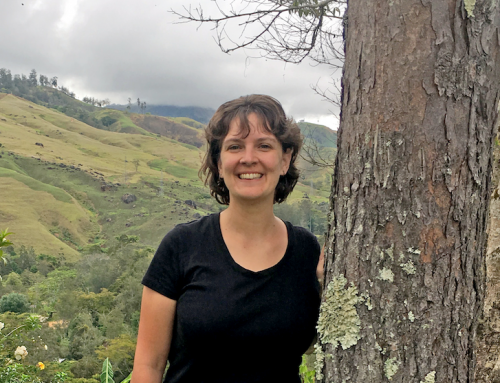

Image Finder for Literacy
Jerry and Joyce McDaniels are the international literacy coordinators for Ethnos Canada and our partners. They said, “Our ministry is focused on literacy: teaching people to read so they can have full access to the translated Word of God in their own language. This certainly involves printed words in the literacy curriculum that we develop. But there
is a secret ingredient that goes into the reading materials. It is the illustrations! Great illustrations contribute to the reader’s understanding of the story, adding interest and details.
“We’ve never had a good way to share images for literacy, so our programming team is putting the finishing touches on the final part of the literacy software called Image Finder. It’s a database that organizes tens of thousands of images
that teams have used in their literacy materials for others to use or adapt.
It will be searchable by word-tags and regions. What a great resource and help this will be to teams all around the world!”
David Burson of the International Ministries Office of Ethnos writes, “We are excited that SIL/Wycliffe is partnering with us to use our Image Finder software. They contributed their excellent database of 11,104 images, which we imported into Image Finder. Recently, we released Image Finder to a team who will review and tag the images in Image Finder, so missionaries who are creating a literacy curriculum for the language they are working in can quickly find the quality illustrations they need.”

The Koval Team
There is a new team formed and a new people group to be reached with the gospel in Papua New Guinea! The team is made up of Rhett and Stacie Stous, Philip and Natalie Hansen, and Steve and Gerdine Stanley.
“After becoming an official team, the next step was to pick where to go. It was an agonizing process! It was easy enough to narrow our options, but to pick one over the other…. It was ever on our minds that one ‘yes’ meant a ‘no’ to every other group! Eventually, we chose to serve among the Koval people. They are a relatively small group (approximately 1,000 people). One thing that especially set them apart in our minds was their strong desire to have missionaries come teach them. They’ve seen life changes in the lives of the neighbouring people group (the Mesi) and have been actively trying to get that message in their own language ever since.”
—Rhett Stous

Bible School Consolidation
For some years now, we have considered the benefits of consolidating our efforts in biblical training onto
one campus. We made the decision to complete the consolidation by the fall of 2020.
The Executive Leadership Team of Ethnos360 (the American sister-organization of Ethnos Canada) has visited the Waukesha campus and will be visiting the Jackson campus to define the process and work with the two teams to identify the best plan forward.
We have informed the Jackson applicants of the approaching move and have given them the option to transition early, if desired, but we will continue accepting students to both Waukesha and Jackson this fall of 2019. We want to prepare well for expansion in Waukesha to receive the students and staff from Michigan with welcoming arms. This year will allow for ongoing preparation on both campuses as students and staff will be transition- ing to the Waukesha campus during the summer of 2020.
—Dan Falls on behalf of the Executive Leadership Team

The Dem Team Moves Forward
In Asia Pacific, some big things are happening for the Dem team. This team is made up of Jared and Melanie Currie, Dylan and Angie Van Rensburg, Jeremiah and Briana Stokes, and Logan and Kendra Teall.
As a team, they have worked hard to get to this point and are excited to be moving closer to the day when they can teach the Dem people God’s Word.
Back in March and April, the entire team went to a coastal town for six weeks to participate in two workshops to start the preparations for translating the Word of God, as well as getting the literacy program ready for teaching the Dem how to read and write in their own language, utilizing the Literacy Starter software.

The Brazil Helicopter Program
How close are we to landing a helicopter in Brazil?
- Pilot — Helicopter pilot Jeremiah Diedrich is on location.
- Land — It’s purchased!
- Land development — Pray for a permit to clear the land and begin construction of a hangar.
- Hangar — Plans are in hand, and a construction company is ready to build it.
- R66 helicopter — Thank you to all our generous partners, who have so far given $848,360 of the $1,799,125 needed for this project! Pray that we can buy a fairly new helicopter in country to avoid import duty and shipping and to save time.
The helicopter can’t come soon enough for church planting teams needing viable transportation.

Kaje Bible Lessons
This is an exciting time for the team that is ministering to the Kaje people group in Papua New Guinea. Taylor Goheen and Jon Myers commented, “We have begun writing the lessons that will be our notes when we teach. We want to make sure that when we stand up and teach, it is done in a natural and clear manner. To do this, we need help.”
God has answered that need by giving them three Kaje men to work with them: Mbinge, Jepun and Nggomo. They will hear the Scriptures before the rest of the group will, helping the two men write the lessons word for word. What a challenge for those three men to hear the Word for the first time! Pray for the three by name.

The Roots of God’s Talk
Translating God’s Word into the mother tongue of a people group is vital. That’s the language that reaches their heart. Jack Crabtree, missionary to the Wantakians of Papua New Guinea, shares how his Wantakian friend explains this. He said, “God’s Word is like this massive tree. When we hear it in the trade language, it’s like we’re just jumping around in these high branches up on top. But I just heard it in my own language, and I heard the roots of God’s Talk.” Pray for Bible translators.

It’s God’s Thing
Daapoi couldn’t understand why the missionaries were so fascinated with rainbows. He watched in amazement as they “Oohed” and “Aahed” and even took pictures. Why weren’t they afraid of them? Why did they seem to actually like them? Didn’t they know that rainbows were a weapon of the evil spirits?
In an animistic belief system such as that of the Dao people from the Asia-Pacific Region, beliefs are based on verbal stories passed down from the ancestors from generation to generation. They are believed without question. The Dao people had always been told that rainbows were the walking sticks of the spirits used to bring people harm.
So seeing one in the sky didn’t bring delight but terrible dread. What bad thing was about to happen now?
But as Daapoi helped the missionaries translate the Bible into his own language, he found out the truth. He learned that a rainbow is a promise from God never again to flood the earth as He did in Noah’s time.
“Wow! This is really important talk. Now I finally understand why you have liked it so much. It is because it is God’s thing, not the evil spirit’s thing. I have taken this talk today and have put it into my heart.”
—Debbie Burgett, Staff Writer





